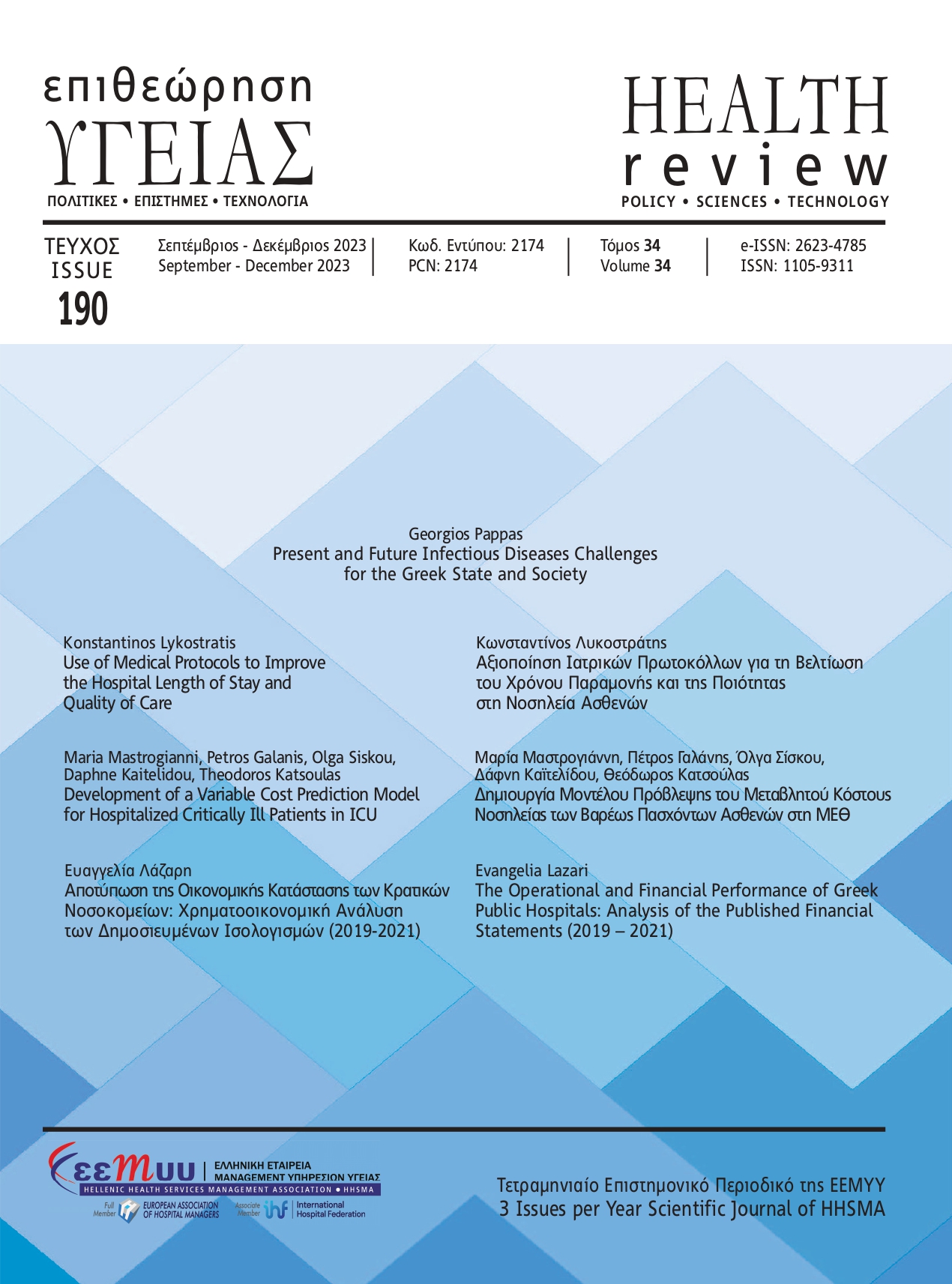
3 Issues per Year Scientific Journal of HHSMA
Editor in Chief: Georgia Oikonomopoulou MSc, PhD(c), Chair of HHSMA Board, Board Member of EAHM
Latest Published Articles
The current pandemic caused by severe acute respiratory syndrome coronavirus 2 (SARS-CoV2) has redefined normality in many social parameters, and has imposed (and continues to) a significant additional burden on health settings, economy, and state resilience worldwide. On the other hand, the SARS-CoV-2 pandemic has highlighted the vulnerabilities that pre-existed in our planning for facing major health-related events. One wonders though whether these lessons are learned, and whether they can be implemented in real life, particularly in a country like Greece, that is still under the shadow of the financial distraught of the previous decade. Based on the Global Health Security Index,1 which measures individual countries’ capability and infrastructure adequacy to deal with epidemics and pandemics, Greece has not exhibited systematic progress in improving aspects of health security that lagged behind the global average. For example, the Greek score for immunization exhibited a significant decline between 2019 and 2021. Other aspects that improved, or remained steady, between the 2019 and 2021 evaluations have not yet reached the global average, as is for example the zoonotic disease, emergency preparedness and response planning, dual-use research and culture of responsible science, real-time surveillance and reporting, case-based investigation, risk communication, medical countermeasures and personnel deployment, healthcare access, communications with health-care workers during a public health emergency, specific funding for correcting gaps identified by Joint External Evaluation or Performance of Veterinary Sciences, financing health, commitment to sharing of genetic and biological data and specimens, infrastructure adequacy, and environmental risks. That’s a lot of work to be done, and it has to be performed in times with significant infectious disease risks, either circulating or anticipated.
Improving the quality of patient care includes measures to reduce hospitalisation time and improve recovery conditions and consequently patient safety during their stay in the hospital. The most common complications that arise during the nursing of patients in hospitals, which lead to extended length of stay, are hospital-acquired infections and thrombotic events. In our efforts, as the Naousa General Hospital, to reduce the incidence of these complications, we proceeded to the creation of specialized medical protocols for their prevention, early diagnosis, and treatment. We recorded measurements and results of improvements in various cases and different implementation times of medical protocols and processed the collected data with specific statistical indicators. Through the statistical analysis of the data recorded, we found significant benefits and a noticeable improvement in key performance and quality indicators in the overall conditions of hospitalisation of patients. We conclude that by applying and utilizing specific medical protocols and monitoring their results, we can reduce the incidence of hospitalacquired infections and thrombosis, thus we achieve to reduce the average length of stay in our hospital and increase the overall quality and safety of care. Our findings clearly indicate that investment of human and financial resources in the development, evolution, and proper application of protocols can have multiple benefits, both to patients and hospital organisations.
Introduction: Hospitalization of critically ill patients in the ICU is one of the most expensive areas of hospital care. Aim: The creation of a variable cost prediction model for hospitalized patients in ICU. Material and method: A retrospective observational study was carried out, using the bottom-up costing methodology. The study sample consisted of 204 hospitalized patients in the 7-bed ICU of 251 AGH, from January 1, 2016 to December 31, 2017. The demographic and clinical characteristics of the patients were recorded and the variable cost of hospitalization was accurately calculated, through an analytical recording of all the resources required for their treatment. Multivariable linear regression was implemented to investigate the impact of variables, derived from a systematic review conducted on determinants of intensive care costs. Gender, age, length of stay, APACHE II severity scale, type of patient (medical/surgical), and renal replacement therapy were used as independent variables. The average total daily cost of hospitalisation and the average daily costs of laboratory tests, medication, and consumables were used as dependent variables. Results: An increase in APACHE II by one unit and length of ICU stay by one day is associated with an increase in total daily cost by 2.74% and 1.82% respectively, while an increase in age by one year with a decrease of 0.4 %. A medical patient shows 11.62% higher total daily cost than a surgical patient, while renal replacement therapy increases the cost by 79.49%. Conclusions:Variable ICU cost is related to gender, age, severity scale,type of event and need for renal replacement therapy.
Financial statements of public hospitals are prepared by accountants and are audited by Certified Public Accountants and they are the only reliable information that reflects the real financial performance. The accounting information provided is useful to users for transparency, accountability purposes, and decision-making regarding the public management of hospitals. The purpose of this study is to investigate the preparation of audited financial statements, the benchmarking of key operational and financial figures, the analysis of financial figures with cost indicators, and the qualitative analysis of certified public accountants’ audit reports per hospital and per health region for the period from 2019 until 2021. The audited Financial Statements as published on the website of the Ministry of Health and the yearly hospital activity open data from the Business Intelligence (BI-Health) Platform were collected and processed. The analysis demonstrates key financial figures of the Balance Sheet and the Profit and Loss Statement and useful cost indicators for the period from 2014 until 2021. Overall, this study strengthens the idea that accrual accounting and the preparation of financial statements in public hospitals should be a management tool and not only a legal obligation. The financial reporting enhances performance management, effective management of public assets, and policymaking for public health.
